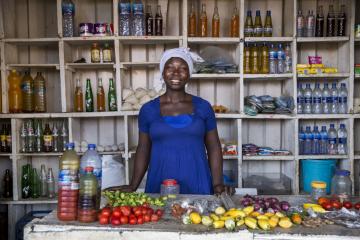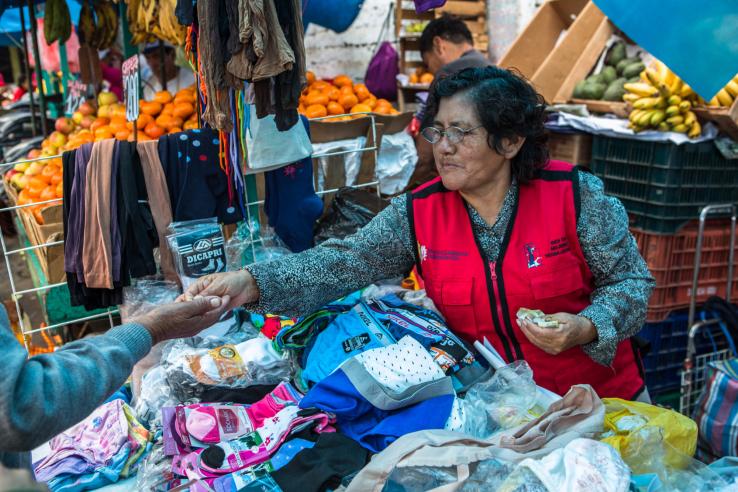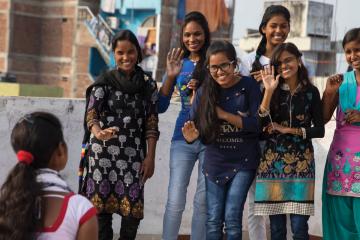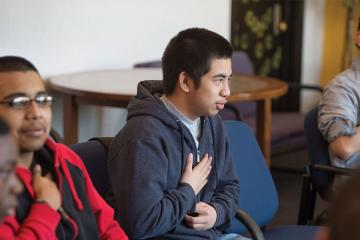
The impacts of economic interventions on intimate partner violence

Summary
An estimated one in every three women worldwide has suffered physical or sexual violence by an intimate partner in her lifetime.1 Intimate partner violence (IPV) can take many forms, including physical, sexual, economic, and psychological abuse. Some of the consequences of IPV include injuries, unintended pregnancies, sexually transmitted infections, long-lasting mental disorders, and, in the most extreme cases, death.2 Achieving gender equality and eliminating violence against women are major global development goals. One popular strategy to reduce IPV is to increase women’s access to financial resources as a way to promote their economic empowerment [1]. This includes economic interventions such as cash or in-kind transfers (e.g., food or other essential products), microcredit, savings groups, or employment as well as asset and property rights, financial inclusion, and agricultural programs.
Economic interventions targeted at women may affect IPV through a variety of channels. Increased income may reduce IPV by improving families’ economic security, thereby reducing household conflict over limited resources, increasing women’s decision-making power and self-confidence, and/or improving their outside options from marriage. By contrast, women’s access to financial resources could also increase the likelihood of household conflict over how to spend resources. Men might also use violence to extract income from their spouses or to assert their dominance in the household.3 4

A review of 22 randomized evaluations and quasi-experimental studies in low- and middle-income countries found that improved access to economic resources had mixed effects on women’s exposure to violence. In nine studies, women who participated in some kind of economic intervention experienced less IPV. On the other hand, two studies found that increasing women’s income led to more IPV, while seven studies found no changes in violence. Finally, four studies found differential effects; for example, programs increased IPV for certain women while decreasing it for others. These mixed impacts are consistent with the various channels discussed above. When implementing economic interventions, policymakers should carry monitoring and action plans to identify and protect women at risk of experiencing more violence. Further research is needed to find interventions that minimize the backlash effects of increasing women’s income.
Supporting evidence
In some cases, increasing women’s income reduced IPV by decreasing households’ financial stress and improving women’s bargaining power.
Programs such as cash transfers might improve households’ overall well-being, particularly by reducing day-to-day conflict and stress over financial resources. Women’s increased income can also improve their bargaining and decision-making power within the household. When one or both mechanisms are activated, researchers have observed reductions in IPV [20] [2] [1] [19] [21] [7] [9]. For instance, two randomized evaluations of unconditional cash and/or food transfers found that these programs reduced women’s experience of violence within their households by 19–52 percent [1] [2]. Three other studies found that cash transfers reduced IPV for some women but not others [19] [20] [21]. Furthermore, in rural South Africa, young women (aged 13–20) who received a cash transfer, conditional on attending high school, experienced a 34 percent reduction in physical IPV. The results suggest that rather than changing power dynamics within existing relationships, the transfers reduced young women’s engagement in sexual relationships, protecting them from abusive partners [5].
In other instances, these programs increased IPV, possibly because conflicts arose on how to use resources or because men decided to use violence to assert their dominance in the household.
Increasing women’s income sometimes led to a backlash effect from partners, especially in households where there were strong imbalances in gender roles [19] [21] [22] [10] [11]. An evaluation of the flagship social protection program in Mexico—which directs cash transfers to women—found that the impacts on IPV varied depending on the amount transferred and the husband's cultural beliefs. In households where women received small transfers, domestic violence fell by 37 percent. On the other hand, large transfers increased the aggressive behavior of some husbands. These differential impacts might be explained by the fact that larger transfers represented a larger increase in the wife’s share of the household’s total income, which might not have been acceptable for older and less educated men [19].
We have not yet identified complementary interventions that consistently reduce IPV when paired with economic interventions.
One alternative to address the unintended impacts of economic interventions on IPV is to combine women’s access to financial resources with programming that purposefully promotes gender equality. These types of activities usually include trainings and family dialogues and seek to encourage participants to actively examine and challenge unequal gender norms that justify this form of violence, such as perceptions of gender roles and notions of masculinity. Several studies have found mixed impacts on this approach [6] [3] [4] [8] [15] [18] [14] [13] [16] [17]. In Burkina Faso, South Africa, and Tanzania, economic interventions reduced IPV when paired with gender-sensitive programming [3] [6] [4]. Similarly, in Liberia, a program that aimed to promote both psychosocial and economic empowerment among vulnerable women found that a combination of intensive psychosocial therapy and vocational skills training reduced emotional and physical IPV by 37 and 58 percent, respectively [8]. On the other hand, evidence from Afghanistan, Colombia, Côte d’ Ivoire, DRC, South Africa, Peru, and Uganda show that adding gender-sensitive components to economic interventions did not lead to reductions in IPV [12] [13] [14] [15] [16] [17] [18]. One potential reason for these mixed results is the varied forms these complementary programs took in terms of curriculum, length, and frequency of meetings; whether they involved only women, men, or both; and context-specific gender and cultural dynamics. Further research is needed to identify design components that consistently prevent the backlash effects of increasing women’s income.
Providing women with access to financial resources can be a tool to reduce IPV.
However, in light of the potential adverse effects of economic interventions, policymakers should take precautions to protect women at risk of experiencing more violence. Evidence has shown that programs seeking to improve women’s access to financial resources can have differential impacts among participants [21] [19] [22]. When implementing such programs, policymakers should take measures to mitigate adverse effects. For example, they should invest in monitoring and data collection throughout program implementation to identify at-risk women and direct them to support services (e.g., counseling, prosecution, shelters). Future research should work to understand the features of women, households, and contexts in which economic interventions increase IPV.
Abdul Latif Jameel Poverty Action Lab (J-PAL). 2022. "The impacts of economic interventions on intimate partner violence." J-PAL Policy Insights. Last modified July 2022.
World Health Organization. 2021. “Violence against Women.” https://www.who.int/news-room/fact-sheets/detail/violence-against-women, accessed July 11, 2020.
World Health Organization. 2021. “Violence against Women.” https://www.who.int/news-room/fact-sheets/detail/violence-against-women, accessed July 11, 2020.
Buller, Ana Maria, Amber Peterman, Meghna Ranganathan, Alexandra Bleile, Melissa Hidrobo, and Lori Heise. 2018. “A Mixed-Method Review of Cash Transfers and Intimate Partner Violence in Low- and Middle-Income Countries.” The World Bank Research Observer 33, no. 2: 218–258. https://doi.org/10.1093/wbro/lky002.
Angelucci, Manuela and Rachel Heath. 2020. “Women Empowerment Programs and Intimate Partner Violence.” AEA Papers and Proceedings 110: 610–614.
Research Paper https://doi.org/10.1257/pandp.20201047.
Hidrobo, Melissa, Amber Peterman, and Lori Heise. 2016. “The Effect of Cash, Vouchers, and Food Transfers on Intimate Partner Violence: Evidence from a Randomized Experiment in Northern Ecuador.” American Economic Journal: Applied Economics 8, no. 3 (July): 284–303.
Haushofer, Johannes, Charlotte Ringdal, Jeremy P. Shapiro, and Xiao Yu Wang. “Income Changes and Intimate Partner Violence: Evidence from Unconditional Cash Transfers in Kenya.” NBER Working Paper #25627, July 2019.
Ismayilova, Leyla, Leyla Karimli, Eleni Gaveras, Alexice Tô-Camier, Jo Sanson, Josh Chaffin, and Rachel Nanema. 2018 “An Integrated Approach to Increasing Women’s Empowerment and Reducing Domestic Violence: Results of a Cluster-Randomized Controlled Trial in a West African Country.” Psychology of Violence 8, no. 4: 448–459.
Kapiga, Saidi, Sheila Harvey, Gerry Mshana, Christian Holm Hansen, Grace J Mtolela, Flora Madaha, Ramadhan Hashim, Imma Kapinga, Neema Mosha, Tanya Abramsky, Shelley Lees, and Charlotte Watts. 2019. “A Social Empowerment Intervention to Prevent Intimate Partner Violence against Women in a Microfinance Scheme in Tanzania: Findings from the MAISHA Cluster Randomised Controlled Trial.” The Lancet Global Health 7, no. 10 (October): e1423–e1434.
Kilburn, Kelly N., Audrey Pettifor, Jessie K. Edwards, Amanda Selin, Rhian Twine, Catherine MacPhail, Ryan Wagner, James P Hughes, Jing Wang, and Kathleen Kahn. 2018. “Conditional Cash Transfers and the Reduction in Partner Violence for Young Women: An Investigation of Causal Pathways Using Evidence from a Randomized Experiment in South Africa.” Journal of the International AIDS Society 21, no. S1 (February): 47–54.
Kim, Julia, Giulia Ferrari, Tanya Abramsky, Charlotte Watts, James Hargreaves, Linda Morison, Godfrey Phetla, John Porter, and Paul Pronyk. 2009. “Assessing the Incremental Effects of Combining Economic and Health Interventions: The IMAGE Study in South Africa.” Bulletin of the World Health Organization 87, no. 11 (November): 824–832.
Roy, Shalini, Melissa Hidrobo, John Hoddinott, and Akhter Ahmed. 2019. “Transfers, Behavior Change Communication, and Intimate Partner Violence: Post-Program Evidence from Rural Bangladesh.” The Review of Economics and Statistics (December) 101 (5): 865–877.
Park, David Sungho and Naresh Kumar. 2022. “Reducing Intimate Partner Violence: Evidence from a Multifaceted Female Empowerment Program in Urban Liberia.” Working Paper, July 2022.
Sanin, Deniz. 2022. “Paid Work for Women and Domestic Violence: Evidence from the Rwandan Coffee Mills.” Working Paper, March 2022.
Erten, Bilge and Pinar Keskin. 2021a. “Female Employment and Intimate Partner Violence: Evidence from Syrian Refugee Inflows to Turkey.” Journal of Development Economics 150 (May).
Erten, Bilge and Pinar Keskin. 2021b. “Trade-Offs? The Impact of WTO Accession on Intimate Partner Violence in Cambodia.” The Review of Economics and Statistics 1–40.
Gibbs, Andrew, Laura Washington, Nada Abdelatif, Esnat Chirwa, Samantha Willan, Nwabisa Shai, Yandisa Sikweyiya, Smanga Mkhwanazi, Nolwazi Ntini, and Rachel Jewkes. 2020. “Stepping Stones and Creating Futures Intervention to Prevent Intimate Partner Violence among Young People: Cluster Randomized Controlled Trial.” Journal of Adolescent Health 66, no. 3 (March): 323–335.
Gibbs, Andrew, Julienne Corboz, Esnat Chirwa, Carron Mann, Fazal Karim, Mohammed Shafiq, Anna Mecagni, Charlotte Maxwell-Jones, Eva Noble, and Rachel Jewkes. 2020. “The Impacts of Combined Social and Economic Empowerment Training on Intimate Partner Violence, Depression, Gender Norms and Livelihoods among Women: An Individually Randomised Controlled Trial and Qualitative Study in Afghanistan.” BMJ Global Health 5: e001946.
Tankard, Margaret E., Elizabeth Levy Paluck, and Deborah A. Prentice. 2019. “The Effect of a Savings Intervention on Women’s Intimate Partner Violence Victimization: Heterogeneous Findings from a Randomized Controlled Trial in Colombia.” BMC Women's Health 19, no. 17 (January).
Gupta, Jhumka, Kathryn L. Falb, Heidi Lehmann, Denise Kpebo, Ziming Xuan, Mazeda Hossain, Cathy Zimmerman, Charlotte Watts, and Jeannie Annan. 2013. “Gender Norms and Economic Empowerment Intervention to Reduce Intimate Partner Violence against Women in Rural Côte d’Ivoire: A Randomized Controlled Pilot Study.” BMC International Health and Human Rights 13, no. 46 (November).
Noble, Eva, Liliana Ascencio, Thomas Wilondja, Aloys Mateba, Manuela Angelucci, and Rachel Heath. “The Impact of Women for Women International’s Economic and Social Empowerment Program in the Democratic Republic of Congo.” Working Paper, 2020.
Agüero, Jorge and Verónica Frisancho. 2018. “Sumaq Warmi: Reducing Violence Against Women in Microfinance.” Inter-American Development Bank, Technical note no. 1387 (February).
Green, Eric P., Christopher Blattman, Julian Jamison, and Jeannie Annan. 2015. “Women's Entrepreneurship and Intimate Partner Violence: A Cluster Randomized Trial of Microenterprise Assistance and Partner Participation in Post-Conflict Uganda.” Social Science & Medicine 133 (May): 177–188.
Angelucci, Manuela. 2008. “Love on the Rocks: Domestic Violence and Alcohol Abuse in Rural Mexico.” The B.E. Journal of Economic Analysis & Policy 8, no. 1 (October).
Heath, Rachel, Melissa Hidrobo, and Shalini Roy. 2020 “Cash Transfers, Polygamy, and Intimate Partner Violence: Experimental Evidence from Mali.” Journal of Development Economics 143.
Hidrobo, Melissa and Lia Fernald. 2013. “Cash Transfers and Domestic Violence.” Journal of Health Economics 32, no. 1 (January): 304–319.
Kotsadam, Andreas and Espen Villanger. “Jobs and Intimate Partner Violence: Evidence from a Field Experiment in Ethiopia.” CESifo Working Paper # 8108, February 2020.
Related Content

Designing financial services and social protection programs to enhance women’s economic empowerment

Reducing adolescent pregnancy by increasing educational and economic opportunities in low- and middle-income countries
